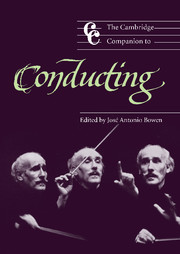9 - The Central European tradition
from Part II - History
Published online by Cambridge University Press: 28 September 2011
Summary
In the second half of the nineteenth century, the conductor developed into an independent musical being, who took sole charge of the performance and was devoted generally to the execution of scores by others. With the deaths of Wagner and Brahms, the public's admiration and loyalty shifted from the composer to the virtuoso conductor. On posters, programs, and record jackets, the names of conductors grew larger as they gradually began to dominate the publicity that accompanied orchestral and operatic performances. By the middle of the twentieth century, conductors had become central to the marketing of music by record companies, opera houses, and concert organizations and were powerful figures in the music business.
With the increasing dominance of the conductor in the nineteenth century, two types of conducting emerged: Mendelssohn's more mechanical model of a “transparent” conductor, as preserved at the Leipzig Conservatory, and the more “subjective” approach of Liszt and Wagner, where the execution of the “external” musical details was dependent upon finding the true “internal” meaning of the work. The latter idealist view became dominant and helped to establish both a core repertory of Austro-German musical works and the German Romantic ideology that sustained them. As the visibility of composers diminished, their scores gradually acquired an iconic status and later conductors challenged this model of performance, proposing a reversal of interpretative loyalty from the interior to the surface of the score. By the middle of the twentieth century, the printed material was paramount and the modifications that a conductor could make to the text were severely limited.
- Type
- Chapter
- Information
- The Cambridge Companion to Conducting , pp. 114 - 133Publisher: Cambridge University PressPrint publication year: 2003



